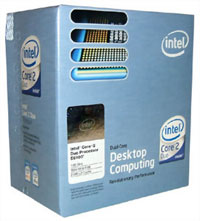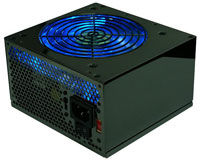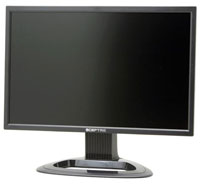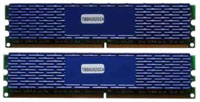Upgraded Midrange Configuration
We've covered our basic recommendations, but of course there's a lot of fine tuning that can be done. The price bracket that can be defined as being midrange is pretty large; some people feel midrange is closer to $1000 while others feel it's closer to $2000. We would say $2000 is more of a high-end configuration, but as we mentioned earlier you don't need to purchase every upgraded component when customizing your own midrange build. Here then are the upgraded midrange recommendations.
| Intel Mid-Range Performance System |
| Hardware |
Component |
Price |
Rebates |
| Processor |
Intel Core 2 Duo E6600 (2.40GHz 4MB Shared) - Retail |
$317 |
|
| Motherboard |
ASUS P5B-E (P965 775) |
$151 |
|
| Memory |
Super Talent 2x1GB DDR2-800 (T800UX2GC4) |
$268 |
|
| Video Card |
Sapphire Radeon X1950XT 256MB (100186L) |
$256 |
$30 |
| Hard Drive |
Western Digital 500GB SATA 3.0Gbps 7200RPM 16MB (Caviar SE16) |
$148 |
|
| Optical Drive |
LG Black 18X DVD+R (GSAH22N-BK) |
$36 |
|
| Case |
Lian Li PC-7B plus II |
$103 |
|
| Power Supply |
Rosewill SLI 600W (RP600V2-S-SL) |
$73 |
|
| Display |
Sceptre x22wg-Gamer 22" 5ms DVI+HDMI (1680x1050) |
$365 |
$20 |
| Sound Card |
Creative Sound Blaster X-Fi XtremeGamer 7.1 |
96 |
|
| Speakers |
Logitech Z-5300e 5.1 280W THX Speakers |
$159 |
|
| Keyboard and Mouse |
Microsoft Comfort Curve 2000 B2L-00047 |
$28 |
|
| Operating System |
Windows XP MCE 2005 (with Vista coupon) |
$115 |
|
| Bottom Line |
|
$2115 |
$2065 |
 |
As you can see, we've limited our performance upgrade to the Intel platform. AMD is still be reasonably competitive with the E6600 when using their X2 5000+, but we definitely give the edge to Intel and the prices of those two processors are about the same. A few of the less critical components stayed the same, but we've upgraded almost everything.
The upgraded processor improves clock speed over the E6300 by 28%, and the 4MB L2 cache typically adds another 5% to 15% performance depending on the application. It ends up being about 40% more processor performance for a price increase of 70%, which really isn't that bad in terms of CPU price/performance scaling.
The ASUS P5B-E motherboard isn't going to be noticeably faster than the Biostar 965PT, but it does have some extra features. The ASUS board adds FireWire support, three more internal SATA ports and one eSATA port, RAID 0/1/5/10 support, a slightly different expansion card slot arrangement, and a different onboard audio solution. The ASUS P5B-E is also one of the better overclocking motherboards, especially in its price bracket.
Along with the faster processor and upgraded motherboard, we selected some Super Talent DDR2-800 memory with 4-4-3 timings. The performance benefit of the faster memory probably isn't worth the extra $40 ($70 after OCZ rebate) unless you plan on overclocking, and we will be using this same memory on the overclocking configuration. These Super Talent DIMMs allow for up to 2.2V officially and should come close to matching the performance of many of the $400+ memory kits. Timings will likely need to be relaxed a bit more, but overall they are very good DIMMs.
 |
There are quite a few good graphics cards in the $200-$300 price range, and for the performance configuration we selected one of the faster models. The X1950 XT 256MB is nearly as fast as the full X1950 XTX in most situations, but it's priced about $100 lower. There are a few games and applications that can benefit from having 512MB of memory, but even then the performance difference is rarely more than 10% so the 40% price increase is hard to justify. Anyone interested in running a CrossFire setup would need to choose a different graphics card, as there are no 256MB X1950 XT CrossFire cards right now, but we wouldn't recommend CrossFire or SLI as a reasonable gaming solution unless you are already running at least a GeForce 8800 GTS or faster graphics card.
 |
The hard drive, power supply, and display upgrades all take the same approach: bigger is better! If you're not the type of person to fill even a 250GB hard drive, obviously the hard drive upgrade is unnecessary. The Rosewill 600W power supply is probably overkill, but users who plan on adding multiple hard drives and perhaps a second graphics card in the future probably won't feel too bad about spending an extra $10. Whether or not the Rosewill 600W is really that much better than the Fortron Source 450W is debatable, but most people have been pretty pleased with the midrange Rosewill offerings. Just be aware that they aren't particularly quiet.
 |
The 22" LCD has the same resolution as the 20" LCD in our base configuration, but it does have a few other advantages. The Sceptre x22wg-Gamer boasts a 5ms response time (versus 8ms), but more importantly it includes HDCP support and it also has an HDMI input. Acer offers a couple of similar 22" LCDs that are worth considering, and if you are primarily concerned with image quality we would rate them as being more or less equivalent to the Sceptre (most of the 22" LCDs use the same panel after all). For $50 less you can forget all about HDCP support and just get a standard LCD, or you can save $20 and still get HDCP but drop the HDMI port. Several other companies offer similar LCDs, with prices ranging from $300-$400, but if you want to get something larger than a 22" LCD the next step up will be the 23" and 24" models that cost at least twice as much. We'll save such displays for the High-End Buyer's Guides.
 |
The last two upgrades are a change of case and improved audio, neither of which are truly a critical upgrade. The Lian Li cases do look nice and they are invariably very high-quality designs, and the PC-7B Plus II has been popular for quite some time. Unlike the basic case, the Lian Li features an aluminum construction that reduces the weight and helps to avoid sharp edges on the interior. It also comes with two 120mm fans which should help to provide exceptional cooling for all but the most demanding builds. The drawback of the two fans is that they do tend to create more wind noise, but you can always unplug the front fan if that's a concern.
 |
As for the speakers, the Logitech Z-5300e speakers certainly sound better than the cheaper Logitech X-530, but they also take up more space. The subwoofer in particular is very large (as is the remote), and for many environments the sound output may be overpowering. There's also no point in investing in really nice speakers if you don't intend to use a higher-quality soundcard, which is why we've included the Creative Sound Blaster X-Fi XtremeGamer. The X-Fi will primarily help in gaming applications, but it does provide cleaner audio than onboard solutions as well. Multimedia enthusiasts might also be interested in adding a TV tuner card, in which case we would look towards either the NVIDIA DualTV, ATI Theater 650, or one of the Hauppauge offerings.
Altogether, the various performance upgrades add almost $800 to the total cost. We do feel that every one of the upgrades is justifiable, but most people probably aren't looking to spend upwards of $2000 on a new computer. This is definitely a high-end configuration rather than a midrange system, but we wanted to give a list of good potential upgrades without drifting off into long-winded debates about which upgrades are the most important. If you want a good start to a high-end computer, you can of course take this list and run with it you will be very pleased. If you want more of a middle ground, the speaker, case, motherboard, and memory upgrades are the first areas we would look to trim costs.


















43 Comments
View All Comments
dm - Friday, January 19, 2007 - link
Hey, I like this article. Very nicely written and "right on time"!!! Btw, if I may request, could you guys make a write up about "specialized" items? I mean, like this pico PSU and Mini-ITX combo:http://fanboyreview.blogspot.com/2006/01/tech-link...">http://fanboyreview.blogspot.com/2006/0...link-pow...
http://fanboyreview.blogspot.com/2006/02/press-rel...">http://fanboyreview.blogspot.com/2006/0...ss-relea...
I'd love to see you guys build one, bring it to the test bench, and tell use where to get those parts. I just can't find them :(
Le Québécois - Friday, January 19, 2007 - link
I think this is the first Buyer's guide from Anandtech.com that I read that doesn't completely include both Intel and AMD. Yes it still mention what AMD could be use if you don't go with the listed Intel configuration but it doesn't tell you the price or what motherboard you should buy if you would choose to go with AMD. I know AMD is not the best way to go right now but still I find this a little confusing when I go back in the "Mid-Range Buyer's Guide, September 2005" and find this :But still that guide provided us with both Intel and AMD options.
Yes AMD is on the first page with Intel but it's the only page for this guide. What's happening to Anandtech integrity? Or it's just the way every guides will appear from now on even if AMD manage to get back at Intel?
If it's the case, I don't think it's a good idea because some peoples are fanboys and will never go with AMD or Intel and leaving out either Intel or AMD from a guide may leave these persons in the dark since many of them don't take times to read every articles that are published on Anandtech.
JarredWalton - Saturday, January 20, 2007 - link
Honestly, I got tired of putting together system configurations that I really wouldn't recommend. The AMD configuration listed is very good for a midrange PC, so I included it. As a gaming platform, AMD is still fine, but if you want a high-end gaming system would you really want to pair it with a lesser CPU? Overclocking there's really not much point in getting a new AMD right now, I don't think - some of the lower end parts and the Opteron models can overclock pretty well, but when Core 2 leads in clock-for-clock comparisons and you can usually get an extra 500+ MHz out of it, it's just not even close.Really, I thought it would be more interesting to take a look at several different options for a midrange computer rather than doing the same old thing again. The way I see it, most of the changes made are minor upgrades to the CPU/mobo, so only the other parts are really changing. You could use the base AMD system and make the same upgrades, only keep the mobo constant, and you'd pretty much be fine. I still have several dozen PCs that have AMD processors and only one Core 2 of my own, for what it's worth. (No need to upgrade any of the systems right now, as they're fast enough.)
yyrkoon - Sunday, January 21, 2007 - link
This is from a motherboard that you guys recently did a spot light on in one of your CES articles. 900MHZ - 1.1 GHZ is a bad overclock ?
http://www.newegg.com/Product/CustratingReview.asp...">http://www.newegg.com/Product/CustratingReview.asp...
Post #5, and I suppose someone could possibly fabricated their review, but this one person isn't the only person on newegg claiming this motherboard is a very good overclocker, perhaps you guys should convince AMD + ABIT sending you parts for review ?
Now, on the reverse side, I'm still not quite sure it is worth investing in an AMD CPU for overclocking, Intels current CPUs seem a bit cheaper overall, but hey, the opterons might not be fully supported on this motherboard, but they seem to be working, and quite well, according to several reviewers.
JarredWalton - Sunday, January 21, 2007 - link
You can get Opterons to hit ~3.0GHz with pretty much full stability, but when those cost as much as an E6400 that will hit 3.5+ GHz with full stability, it's pretty clear why we think Core 2 is the better overclocking choice. A 50% or higher overclock is nothing to scoff at, but E6300 is basically only limited by motherboard and RAM in many cases, and E4300 ought to hit 100% overclocks routinely. (Yikes!)yyrkoon - Sunday, January 21, 2007 - link
Yeah, I never said it was a viable comparison, but for die hard AMD fans, its definately an option. I mean, what I would really like to see, is some real world hard data, on an Opteron vs maybe each of the conroe CPUs. I've little doubt, all CPUs overclocked, that every Conroe would outperform anything AMD, however, how much of a real world difference would it really make ?Some of us have already invested into AM2 systems, and could upgrade a good bit cheaper to an Opteron, vs. a C2D CPU, so the real question is, is it really worth the cost of the motherboard, to go that route, instead of just buying an Opteron? We've all seen your game numbers for FPS etc., but would those numbers really translate into a hugely noticeable difference ?
I for one, if gone C2D, would buy a top of the line i680 board (most likely ABIT), and probably an E6600, if gone AMD, an Opteron 1214-1216 (I like the even numbered, higher multiplier on the 1216), and the ABIT motherboard mentioned above. Also, since my business partner here just purchased the that ABIT AM2 board, I have the luxury of seeing it in action, before I purchase for myself.
Also, since i payed only $54 for my current system board, and not very much for the single core 3800+ im currently using, its not as though I'm out a whole lot, no matter what I do. One thing is for sure however, this motherboard WILL get replaced, I'm not too fond of it, and its not very stable compared to anything I've owned from ABIT.
JarredWalton - Monday, January 22, 2007 - link
How much of a difference it would make depends largely on what sort of application you're running, as well as the other hardware in the system. If you don't have a top end graphics configuration and you're worried about gaming performance, in most cases the difference between the various current processors is going to be very small. If you're running a couple of 8800 GTX cards, the difference could be quite a bit larger depending on resolution. I figure anyone that has the money to buy a couple of 8800 GTX GPUs should probably already have at least an E6600 processor, because if you're willing to spend that much money on graphics cards $300 on a processor doesn't seem like a whole lot.Other applications (3D rendering, video encoding, office tasks) will show more or less of a difference. Core 2 Duo should be faster in most of those, especially with overclocking, but if you never happen to run any of those tasks it really doesn't matter much. If you already have a decent AM2 setup and can hold out, I would be far more interested in waiting to see what the K8L processors can manage to do -- granted that appears to be about six months out, but I doubt anything significant is going to happen in the software market before then that would necessitate a CPU upgrade. (Maybe Vista might do it?)
yyrkoon - Monday, January 22, 2007 - link
Yeah, well I for one, am not too enthusiastic about the socket F platforms (assuming this is what you mean about K8L). I used to follow the road maps of each side, to the point that I would be easily disappointed when the chips actually arrived. Now, I just wait, and see what happens when it happens, at least, for CPUs. Personally, the technology I've been following for a while, thats not due out until perhaps quarter 3 is PCI-E v2.0, and the PCI-E to PCI-E peer to peer communications (potential of 160Gbit/s throughput . . .). Something tells me though, that either 1) this technology will be further out than quarter 3, 2) is all smoke an mirrors, 3) will cost WAAAAY more than 10GbE currently costs now.Anyhow, my point basically is, you can wish in one hand, and .... in the other, and see which one fills up faster. In other words, it wont happen, until it happens :)
JarredWalton - Tuesday, January 23, 2007 - link
I'm pretty sure AMD is going to release some sort of updated CPU (quad core maybe - not sure on that) for AM2 round about summer time. My understanding (which admittedly could be wrong) is that K8L will be available for socket F as well as AM2, just like the current K8 line. Socket F just supports multiple CPU sockets whereas AM2 is for single chips. That's why we have Opteron 12xx parts for AM2 and 22xx/82xx for socket F.As for PCI-E stuff, most of the new items won't really matter on the desktop. It's like having a PC with 80GB/s of memory bandwidth; if the CPU only needs 5-8GB/s everything else is just wasted.
Le Québécois - Saturday, January 20, 2007 - link
OK, thanks for taking some of your time to explain why you did this. I don't have any things personal against this approach since I do read every one of Anandtech articles and have no problem building a computer on my own.I understand you got tired of writing about 2 differents builds of computer (AMD and Intel) for every guide even if one of those isn't a good choice (computing power or cost). I just found it odd to see it at this time when AMD is no so bad (I would buy a Core 2 Duo if I was looking for a computer right now but I'm still not ready to change my old one) and not a some times ago when Intel was like AMD is today, if not worst, like in the Buyer's Guide where I took my quote from.
Now if I think about it, maybe it's a good thing since it will force the fanboys to do some real research before blindly buying AMD or Intel just because of the name.
One last thing, when you say :
Are you saying that you personally own those PCs?
If so can I ask what are you doing with such an amount of PCs?